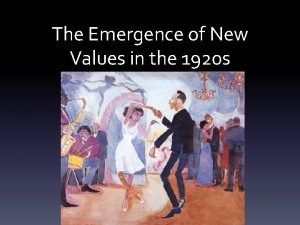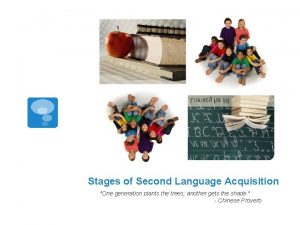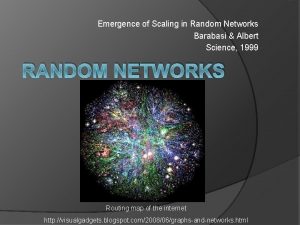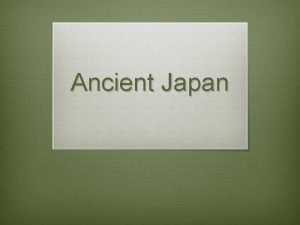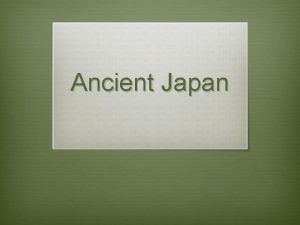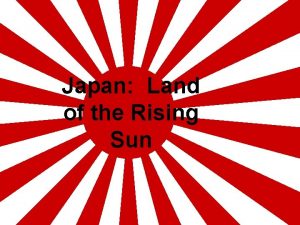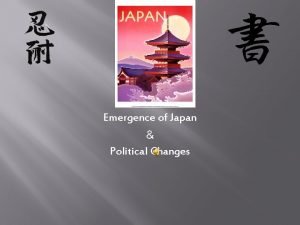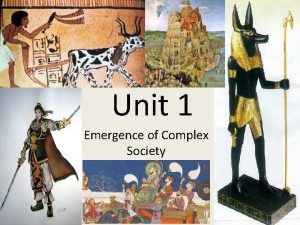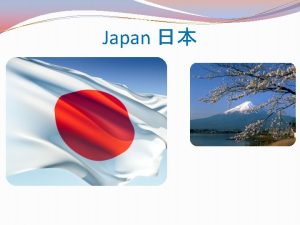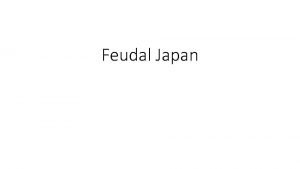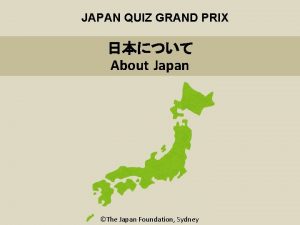The Emergence of Japan Geography Japan a Land


















- Slides: 18

The Emergence of Japan

Geography: Japan, a Land Apart • Archipelago – • 4 main islands: Hokkaido, Honshu, Kyushu, Shikoku • Land Sea • 4/5 of land is too mountainous to farm • Most people farm in narrow river valleys and along coastal plains; was an obstacle to unity • Plentiful resources in the seas for trade and diet


Geography: Japan, a Land Apart • Tsunami – • Mount Fuji is a symbol of beauty and majesty in nature

- Migrated from the Asian mainland 2000 years ago - Pushed early inhabitants, the Ainu, onto the island of Hakkaido • Yamato Clan • Society divided into uji – • Had its own chief, gods and goddesses • Women were respected • 500 AD – Yamato clan ruled Honshu (largest island) for 1000 years • Set up first and only dynasty; claimed direct descent from the sun goddess, Amaterasu • Chose the rising sun as its symbol • Emperors looked upon as living gods; Japanese emperor still traces its roots to the Yamato Early Traditions

• Shinto – “the way of the gods” • Tradition still lives today; shrines located in beautiful natural surroundings • Mountains, waterfalls, gnarled trees • The Korean Bridge • Japan and Korea have always been in contact • Shared artistic and cultural skills with each other • 500 AD – missionaries from Korea brought Buddhism • Chinese writing and culture was introduced Early Traditions

- 600’s: Prince Shotoku sent nobles to study in China; visited the Tang dynasty • Imported from China • Learned ideas of government including the idea of a “Heavenly Emperor” with absolute power • Strengthened central government with a bureaucracy • 710 AD – built new capital at Nara; spoke and dressed Chinese; served Chinese tea and food; used Chinese characters to write their history • Adopted pagoda architecture; accepted Confucian and Buddhist ideas; filial piety • Selective Borrowing – • Did not adopt civil service exams • Inherited status through family; officials were sons of nobles Japan Looks to China

- Blending of cultures from 794 – 1185 AD; capital located in Heian • An Elegant Court • Nobleman and women lived in luxury • Pavilions, gardens, lotus pools, elaborate rules for court etiquette • Women were forbidden to learn Chinese; but did produce some of the most important literature; The Pillow Book • Lady Murasaki • Marasaki Shikibu • Best known Heian writer • Wrote The Tale of Genji; was the world’s first full length novel The Heian Period

Japan’s Feudal Age

- A warrior aristocracy dominated Japanese society; the emperor was a powerless figurehead - Real power was in the hands of the shogun – - Minamoto Yoritomo was appointed shogun in 1192 AD; he set up the first of three shogunates; his was called the Kamakura shogunate • The World of Warriors • Distributed lands to vassal lords who supported him in war • Daimyo – • Samarai – • Heavily armed and trained in skills for fighting • Bushido – • If you betray the code of bushido you were expected to commit seppuku Japanese Feudalism Emerges

• Status of Women • Some trained to fight, most supervised family estates • As feudalism increased, inheritance was limited to the sons • Did not put women on a pedestal like chivalry • Peasants, Artisans, and Merchants • Peasants • Made up 75% of the population; formed the backbone of feudal society • Cultivated rice and other crops on the estates of samurai • Some served as foot soldiers • Artisans • Armorers and sword makers provided goods for the samurai class • Merchants • Lowest rank in society • Mongol Invasions • Refused to accept Mongol rule • Kublai Kahn tried to invade with 30, 000 troops but was suppressed by a typhoon twice • Japanese credited the victory to the kamikaze - Japanese Feudalism Emerges


• New dynasty took power in 1338 but led to many years of warfare • 1590 AD – General Toyotomi Hideyoshi brought most of Japan under his control • 1600 AD – Tokugawa Ieyasu became master of Japan and was named shogun • The Tokugawa shogunate ruled until 1868 Order and Unity Under the Tokugawas

• Centralized Feudalism • Kept outward form of feudal society but imposed a central government • Created unified, orderly society • The daimyo and his entire family were required to live in the capital with the shogun in Edo to keep them in check • Forbade them to build castles or marry without his permission • Put in place a strict moral code • Only samurai could serve in military or hold government positions • Samurais followed the bushido code • Peasants remained on the land were forbidden to wear luxuries such as silk • Women could be divorced for neglecting household duties Order and Unity Under the Tokugawas

• Economic Growth • Agriculture grew and improved • new seeds, tools, and fertilizer led to surpluses of food • New roads connected towns to the capital • Merchants began to make money and climb the social ladder Order and Unity Under the Tokugawas

• Zen Buddhism emphasizes meditation and devotion to duty • It was accepted by the samurai • Had contradicting messages • Zen monks were great scholars but valued the uncluttered mind and stressed the importance of reaching moment of “non-knowing” • Stressed compassion for all, yet samurai fought to kill • Sought to experience absolute freedom, yet rigid rules gave master complete authority over his students Zen Buddhism and Japanese Culture

Changing Artistic Traditions • Theater • 1300’s – No Plays • Performed on square, wooden platforms without scenery • Each movement had a special meaning • 1600’s – kabuki – • Portrayed family or historical events • Elaborate, colorful costumes; exaggerated movements for action • Bunraku • Literature • Many stories were influenced by Zen values • Haiku • Painting and Printmaking • Reflected Chinese landscape paintings; some told historical events • Woodblock prints

• In 1543, the Portuguese reached Japan. • A growing number of Japanese adopted Christianity. • By 1638, the Tokugawas had barred all western merchants and forbidden Japanese to travel abroad. • Japan maintained its policy of strict isolation for more than 200 years. • Isolation had a profound effect on Japan. • Without outside influence, Japanese culture turned inward. • In 1853, Japan was forced to reopen contacts with the western world. • Renewed relations unleashed an extraordinary period of change that helped Japan emerged as a major world power. Japan and Foreign Traders
 Entrepreneurship during post independence
Entrepreneurship during post independence The emergence of mass society
The emergence of mass society So&e
So&e Speech emergence
Speech emergence The emergence of new values
The emergence of new values Ion storm
Ion storm Paul ruthman committee
Paul ruthman committee Plan emergence madagascar 2019-2023 pdf
Plan emergence madagascar 2019-2023 pdf Plan emergence madagascar 2019-2023 pdf
Plan emergence madagascar 2019-2023 pdf Speech emergence stage activities
Speech emergence stage activities The emergence of mass society
The emergence of mass society Netflix core competencies
Netflix core competencies Emergence theory
Emergence theory Emergence profile
Emergence profile Emergence of scaling in random networks
Emergence of scaling in random networks What are landforms
What are landforms An area of land largely enclosed by higher land
An area of land largely enclosed by higher land Ministry of land infrastructure transport and tourism japan
Ministry of land infrastructure transport and tourism japan Mixed land use definition ap human geography
Mixed land use definition ap human geography




